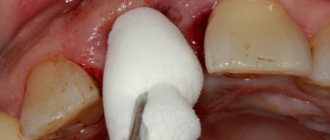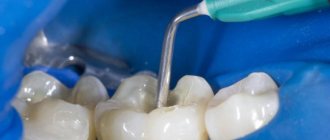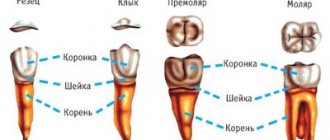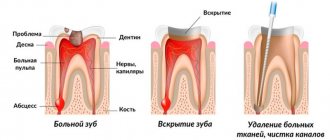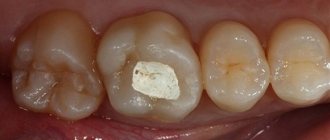What is calcium filling?
For filling, a special composition is used - copper-calcium hydroxide. It has the consistency of a paste, which is injected into the recess with a special tool - a channel filler.
Calcium hydroxide paste completely closes the canal, preventing pathogens from getting inside
To ensure that there are no voids left in the cavity, the tooth is lightly exposed to electric current.
This method performs a therapeutic function: it disinfects tooth tissue, killing bacteria.
The patient walks with this calcium filling for some time. Then the dentist takes it out, rinses it, thoroughly dries the root canal and performs the final filling with a permanent filling.
Procedure for filling teeth with calcium
A filling filled with calcium is temporary and, after a period determined by the doctor, changes to a permanent
one. Installation of a calcium filling involves several stages:
- The doctor mixes calcium powder with distilled water and glycerin to obtain a homogeneous paste.
- Before filling, the doctor cleans the root canal and treats it with special preparations.
- Using a channel filler, the resulting paste is introduced into the recess
- To ensure that the substance adheres tightly to the walls of the canal, it is compacted with a pin, and then the hole is hermetically sealed.
As mentioned above, a calcium filling is temporary. How long it will stay in the tooth is decided by the doctor, based on the specific clinical case. After the prescribed period has expired, the dentist removes the temporary filling and places a permanent one in its place.
Pain after nerve removal and root canal treatment
One of the most common misconceptions among patients is that a tooth without a nerve cannot hurt. In principle, there is truth in this. But it's not that simple. Nerve fibers exit the tooth through the apical foramen in the root and unite into common trunks, thicker and more powerful. Such a trunk may be responsible for the sensitivity of the entire half of the jaw or face. This explains the irradiation (passage) of pain along the entire nerve if the inflammation affects only one tooth. The impulse is transmitted through nerve fibers to neighboring areas - ear, temple, eye, eyelid, forehead, etc. When a nerve is removed (tooth depulpation), it is simply torn off from the main trunk, causing inevitable injury to the tissues. Canal cleaning takes place under anesthesia and the patient does not feel the moment the instrument exits through the tooth. Without proper control over this procedure, a hematoma (local hemorrhage) may form in the area of the apex of the tooth root, which will cause pain when pressing on the tooth or clenching the jaws. A feeling of mild pain in a pulpless tooth is acceptable for 1–2 days. As a rule, with high-quality cleaning of the contents of the tooth cavity, there is no painful reaction from temperature stimuli (cold or hot water), no severe throbbing or aching pain. If the doctor removed the nerve from the tooth, treated the canals and left a turunda with an antiseptic in them, the tooth should not hurt. If, some time after treatment, the patient notices severe pain, which intensifies in the evening or at night, it is necessary to re-clean and rinse the root canals. This needs to be done as quickly as possible; you should not endure the pain or relieve it with medications. Short-term help can be provided by painkillers: Pentalgin, Ketanov, Tempalgin and others.
The occurrence of throbbing pain from hot water after root canal filling
Treatment of tooth canals involves not only treating, cleaning and drying them, but also filling them with special filling materials. As a rule, pastes for these purposes are used with or without anti-inflammatory additives. Filling the canals is necessary in order to eliminate the possibility of creating conditions for the growth of bacteria. When the tooth cavity is densely filled with gutta-percha pins and paste, there are no such conditions. If some of the infected tissue gets behind the root apex during canal treatment, the inflammation spreads to the bone. Pain in the tooth appears almost immediately after root canal treatment or during the first days and has a certain character: pulsating, twitching, shooting, aggravated by heat. In order to eliminate such a complication, it is necessary to carefully treat the tooth canals using the correct technique. If such pain occurs, it is necessary to re-treat the canals; a short-term effect is achieved by taking painkillers with an anti-inflammatory effect: Nise, Ibuprofen. In some cases, rinsing the mouth with a warm soda solution (1 teaspoon of salt and soda per glass of water) has a positive effect.
Beneficial properties of calcium
Preparations containing calcium have an antibacterial effect. Most dental diseases are caused by bacteria that actively multiply in an acidic environment. But an alkaline environment, on the contrary, kills them.
Calcium helps create an alkaline environment in the tooth cavity that is unsuitable for bacterial activity.
To obtain a filling paste, calcium hydroxide powder is diluted with saline solution. Interaction with liquid leads to the release of hydroxyl ions, which kill pathogenic bacteria.
How does calcium work?
Staying in the canal for a certain time, calcium completely kills bacteria living in the tooth
After entering the root canal, the calcium mixture begins to interact with the tissues and microflora of the tooth. The oxide penetrates into the dentin and pulp. When the substance remains inside the canal for a long time, it completely kills the bacteria living in it. After such exposure, the doctor can safely carry out further treatment or fill the canal.
Granulomas on the roots, we treat the tooth canals
In the article “Available about root canal treatment,” I discussed in theory what proper endodontic treatment should look like, and what happens when it is not performed entirely in line with modern requirements. And today I propose to support the theory with practice and analyze one of the interesting clinical cases from my own practice.
So, a young man approached me with a referral from an orthodontist and a desire to save a tooth, or rather, what was left of it. This is how he looked at the time of our meeting on an x-ray.
This is the upper 6th tooth (designated by dentists as 16, there is a lot of detail about the numbering of teeth in dentistry). His background is as follows: a couple of years ago he was treated for pulpitis. Everything was as usual - they removed the nerve, somehow cleaned the canals, filled them and put in a big filling. As you can now see, very little time passed and a natural “accident” happened: the tooth and the filling broke. What’s bad is that one of the walls broke below the gum level. I will explain further why this is bad. As a result, we have 2 main problems that threaten the tooth with removal - a deep level of chipping of the palatal wall (indicated in the picture with a red line) and poorly treated canals (the unpassed part of the canal is indicated by a white dotted line), one of which has radiological signs of chronic inflammation - granulomas (its outlines are indicated by a black dotted line).
But despite these problems, the patient had a strong desire to preserve his own tooth by any means available. What was ultimately done for this?
In order to better understand and evaluate, we must say what shortcomings we had to correct... and what you can see for yourself in the picture of your teeth:
- barely noticeable white stripes on the x-ray - this is the filling material in the canals. Such thin, interrupted “threads” that do not reach the top of the root indicate that the canal was poorly expanded, and therefore not sufficiently treated with solutions to remove organic residues from it
- darkening around the tips of the roots (in this case around one root) indicates the presence of a chronic inflammatory process on this root. This is precisely caused, as a rule, by errors in the processing of the canals during previous treatment.
So, during the re-treatment, it was discovered that in addition to the 3 previously treated canals in this tooth, 2 (!!!) additional canals were missed at once. Those. they were not discovered by the doctor and were simply closed with all the remains of the pulp, which acted as a food storehouse for the microflora. It is on this root that the inflammatory focus is visible on x-ray. In addition, the so-called "step". In dentist jargon, this unpleasant thing means that the doctor has deviated from the natural course of the canal and lost it, resting on the hard tissues of the root. As a result, the apical part of one of the previously discovered canals also remained underprocessed.
The picture on the left shows 3 instruments inserted into 3 different canals in the same root. On the right picture, the black dotted line indicates the outline of the granuloma, the blue line outlines the outline of the root, the white dotted line indicates the untraversed part of one of the 3 canals, the red arrow shows the part of the canal in which a “step” was made during the previous treatment
Ultimately, these errors were corrected, two undetected channels were completely processed, and the step in the third was bypassed by finding the correct path. In total, after all the instrumental preparatory measures, it turned out that there were 5 separate canals in this tooth.
This control image taken before filling shows all 5 individual canals...
This is a photo of a tooth cavity, in which 5 separate orifices of all five canals are visible. Channels 1,2,5 are the main ones. It was they who were found and processed during the previous treatment, although not perfectly. Quite often, there are additional canals in the upper molars (3,4). Their mouths are initially very small, sometimes barely noticeable, and quite often these channels remain undetected. This is one of the common causes of complications after endodontic treatment...
This is quite a rare case. Still, usually in the upper molars there are 3-4 canals, very rarely less than 3. But no less rarely, more than 4. This is just that rare case, and therefore interesting.
The result of 2 visits (1 hour + 1.5 hours) was the filling of all canals.
Now all 5 canals are sealed exactly to the top of the root. All that remains is to wait for the inflammatory process to disappear.
The same thing, but the view from the tooth cavity. The canals are tightly sealed with gutta-percha*. Next comes tooth restoration.
Further, the remaining root due to serious damage will be restored with a stump insert* and a crown. True, before that, the surgeon will still have to tinker with him in order to solve the second problem of this sufferer after the canals (I talked about it at the beginning). We are talking about a deep chip of the palatine wall. The fact is that for high-quality restoration it is very important that the edges of the tooth rise at least 1-2 mm along the entire perimeter above the level of the gum (it is allowed that in some places the edge of the tooth coincides with the level of the gum). This will make the restoration airtight and preserve the remains of the tooth for many years to come. In this case, the wall was chipped on the palatal side below the gum, which means we will have to remove some part of it in order to transform the subgingival defect into a supragingival one. This manipulation is called “surgical lengthening of the clinical tooth crown.” I will also talk about this, though in other posts.
This completes the story of saving one single tooth.
Finally, I want to make a couple of small but important additions to this clinical case.
Firstly, very often in such situations the patient faces a dilemma: keep his tooth, fight for it until the last drop of... the sweat of your dentist, or remove it with subsequent prosthetics? In such cases, the last decision, dear friends, remains with you, the patients. Repeated canal treatment, correcting mistakes already made by the previous dentist (and, perhaps, your own) always remains a difficult task, and therefore no one can ever give a 100% guarantee on the final success of all rescue measures. What factors does the doctor take into account?
Objective:
— the condition of the tooth (and not only the canals)
- opportunities for its subsequent QUALITY restoration (you can perform a feat in the canals, but then, without properly assessing the degree of tooth destruction, make an inadequate restoration, and in the end still lose it)
— the importance of preserving a specific tooth (it seems that all teeth are important, you might say, but there are still situations in which the heroic saving of a tooth makes absolutely no sense, for example, this often happens with wisdom teeth)
Subjective:
- the equipment of your workplace (the presence of a rubber dam, an apex locator, a large number of various files *, x-rays, ultrasound, magnifying equipment - in general, everything that I have already written about earlier and without which “picking in the canals” is impossible). Why do I include completely objective things here? Yes, because, unfortunately, many doctors believe that it is possible to work “high quality” without something from this list, or even without everything at once. Sensitivity of fingers and experience, they say, you can’t drink away, as they say. This is self-deception.
- skills, knowledge, experience - well, everything is clear here... it’s very difficult to soberly evaluate your loved one. And in conditions of high competition, it is still somehow not customary for us to send patients somewhere to colleagues who are more equipped and “advanced” in some narrow issues. Proximity to the body of one's pocket may outweigh the patient's interests.
Based on this, the doctor should try to give an honest, objective prognosis for the success and feasibility of treatment. And remind you that only surgeons using forceps can achieve 100% results. If you are then ready to invest time and money in treatment without guarantees, go to battle. If you do not accept even 1% of possible failure after mutual efforts and your waste of money, you move to the surgeon’s office. In addition, it should be noted that from a financial point of view, canal retreatment followed by prosthetics usually costs the patient about the same as tooth extraction followed by implantation. At the same time, tooth extraction gives a more predictable result. The success of complex endodontic treatment over a 5-year period, even with the most remarkable specialist, does not exceed 70-80%. For implantation, the same figures are approximately 95%. So in the matter of “pulling” hopeless teeth, it is always worth soberly assessing the risks.
And the second addition... The modern protocol for the treatment of chronic inflammatory processes around the root (what is often called a granuloma or cyst ) involves opening and closing the canals as little as possible. What am I talking about? Some time ago it was “fashionable” in cases like the one I analyzed to put “medicine” (calcium preparations) into the channels and “marinate” it there for a long time. At the same time, change it several times with some frequency (and each dentist had his own favorite scheme - some once a week, some once a month, and some in accordance with the phases of the moon... just kidding). At the same time, it was believed that this should be done for 6-12 months and monitor whether the cyst “goes away.” So... This is already a very outdated approach, which has many disadvantages, the main one of which is the absolute pointlessness of keeping calcium preparations in the root canals for a long time. Therefore, such an approach, at a minimum, will not make you better (if you don’t consider wasting your money and your time a big loss), at most, it can do harm (for example, a temporary filling during a long wait by the sea for good weather will begin to “leak” or even fall out, leaving microbes the opportunity to again settle in the tooth canals and immediately making all previous treatment meaningless). Even in cases of exacerbation of inflammation, in the presence of swelling, pain, fistula, discharge from the canal... the modern treatment protocol remains the same - open the canals, thoroughly clean and wash (in case of exacerbation, this stage takes a longer time), immediately seal with permanent materials, make a good sealed restoration, and then sequential monitoring after 3.6 months. All this in 1-2-3 visits within a minimum time. No many months of walking with calcium, no numerous replacements, no walking with an open canal in the tooth, rinsing it and plugging it with cotton wool while eating, no leeches - all this is yesterday and the day before yesterday. If you are offered something like this, you can safely turn towards the exit, you can’t go wrong...

